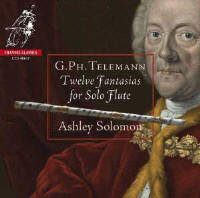Texte paru dans: / Appeared in: |
|
|
Outil de traduction ~ (Très approximatif) |
|
|
Reviewer: Raymond
Tuttle
These works are both a proving ground and a Rorshach test for classical flutists—or at least for flutists who want to play the Baroque repertoire. Almost an hour of the flute, and nothing else, is an unnerving form of nudity for the musician. There is nowhere to hide. How will he or she negotiate it? What will he or she make of it? One decision that the flutist has to make is what instrument he or she is going to play it on. Solomon includes a note with the present release stating, “This recording offers the listener a rare opportunity to hear two unique baroque flutes, both made in 1760 alongside my favorite modern copy. In combining all three on this recording I hope it opens a new sound world for the listener and breathes fresh life into these well-known works by Telemann.” So, in Nos. 4, 5, and 9, Solomon plays a Meissen porcelain flute; in Nos. 6, 7, and 8, he plays a Thomas Cahusac ivory flute; and in the remaining fantasias he plays his usual grenadilla wood flute made in 2004. I did not read this information until I had given this disc an initial listen, and I confess that it didn’t occur to me that Solomon was switching between three different flutes. Now that I am doing A:B:C comparisons, I do notice subtle differences amongst them, but the key word is “subtle.” We are indeed spoiled for choices when it comes to this music. For many listeners, their first exposure to it was Jean-Pierre Rampal’s recording, originally issued by Denon and reissued an LP by Odyssey. Rampal plays a modern metal flute, and in the sustained notes he maintains both rock-solid pitch and homogeneity of timbre. When, in the quicker passages, he has the opportunity to show off a little, he takes it. Barthold Kuijken (Accent), another old favorite, plays a wooden flute made in 1745. His sound is considerably more variegated than Rampal’s, although he frequently shares Rampal’s easy agility. On this new recording, Solomon’s timbre is the most variegated of all (even on the modern flute), and he is considerably more relaxed. If you’re going to listen to all 12 Fantasias at once, I think the advantage goes to Solomon, because his playing has more light and shade than Rampal’s and Kuijken’s. If, on the other hand, you are studying these works one at a time, it is more difficult to choose, because the brilliance and control exhibited by Rampal (in particular) are literally exemplary. Also, Kuijken’s playing dances more than Solomon’s.
As a solo
player, and with the ensemble Florilegium, Solomon has an extensive
discography. I have heard him play many times before in ensembles; this was
my first time hearing him by himself, and I was most impressed. Unless flash
is your first priority, I think you will be very satisfied with Solomon’s
Telemann. | |
|
Support us financially by purchasing this disc from eiher one of these suppliers. Un achat via l'un ou l'autre des fournisseurs proposés contribue à défrayer les coûts d'exploitation de ce site. |
|
|
|
|
|
Cliquez l'un ou l'autre
bouton pour découvrir bien d'autres critiques de CD |
|




